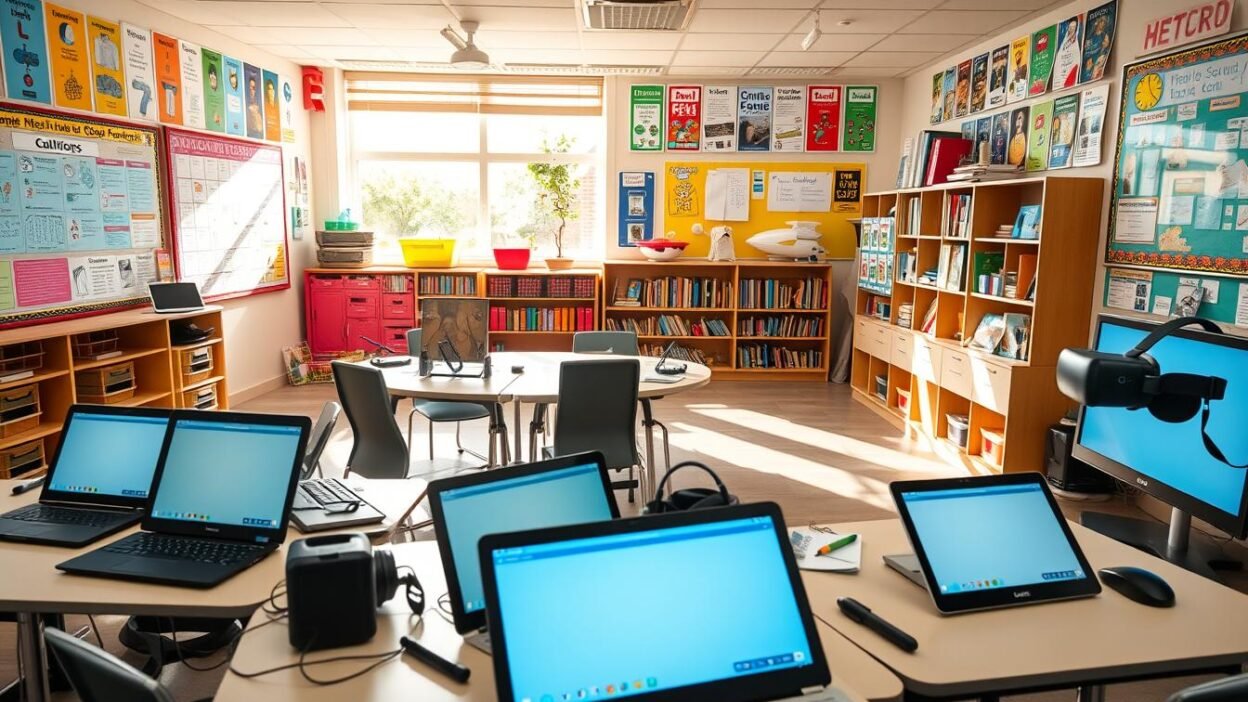In today’s fast-changing education world, Information and Communication Technology (ICT) is making a big difference. It’s changing how we teach and learn. As teachers and future educators, we’re leading a big change. This change uses technology to make education better and score high in UGC NET PAPER 1.
But have you thought about how ICT tools are changing the learning results we aim for?
Let’s dive into this exciting topic. We’ll see how ICT is changing education. We’ll look at digital tools and virtual reality that are making learning better. These tools are helping students succeed more than ever before. Get ready to see how ICT can help the next generation of teachers and students.
Key Takeaways
- Discover the transformative impact of ICT integration on modern education systems
- Explore the latest digital tools and platforms that are revolutionizing classroom engagement
- Understand the role of data-driven decision making in enhancing educational assessment and personalized learning
- Learn about overcoming implementation challenges and best practices for successful ICT integration
- Gain insights into the future of ICT in education and its potential to empower the next generation
Understanding ICT Integration in Modern Education Systems
In today’s fast-changing world, Information and Communication Technology (ICT) has changed how we learn. It has moved from basic tools to advanced digital platforms. Let’s explore how this shift has transformed education.
Defining Educational Technology in Contemporary Learning
Educational technology includes many digital tools and platforms that make learning better. These tools use digital learning platforms to make learning fun and interactive. They help teachers use technology to teach more effectively.
Key Components of ICT-Enhanced Education
- Interactive learning management systems (LMS) that make it easy to share content and track progress
- Multimedia resources like videos and simulations that make learning more engaging
- Tools for teamwork that allow students to work together in real time
- Apps and games that make learning enjoyable
The Evolution of Digital Learning Platforms
The history of digital learning platforms is exciting. From simple e-learning modules to today’s advanced systems, they have come a long way. Now, they offer personalized learning experiences that help both teachers and students succeed.
| Key Milestones in Digital Learning Platform Evolution | Features and Functionalities |
|---|---|
| First-generation e-learning platforms | Basic content delivery, limited interactivity |
| Web-based learning management systems (LMS) | Comprehensive course management, assessment tools |
| Cloud-based, mobile-friendly platforms | Personalized learning paths, real-time analytics |
| Adaptive and AI-powered platforms | Intelligent content recommendations, predictive analytics |
As educational technology and digital learning platforms keep evolving, they open up new ways to improve teaching and learning. We’ll see how technology is changing the classroom in the future.
Impact of Technology on Teaching Aptitude and Methodology
Today, technology is changing education fast. It’s making teaching better by using ICT tools. These tools help teachers give lessons that are more fun, personal, and effective.
ICT tools let teachers reach different students in new ways. Digital learning platforms offer many ways to share information. This keeps students interested and helps them learn more.
Technology also lets teachers see how students are doing in real time. They can use this info to make their teaching better. This makes teaching more effective.
Leveraging Digital Tools for Engaging Instruction
Technology is changing how we teach. It’s moving away from just talking to students. Now, teachers can use things like interactive whiteboards and virtual reality to make learning fun and interactive.
These tools help students work together and think critically. They also make learning more exciting. This can really make students love what they’re learning.
| Teaching Aptitude | Impact of ICT Tools |
|---|---|
| Lesson Planning | Streamlined lesson planning with access to a wealth of digital resources and templates |
| Classroom Management | Improved classroom management through digital tools for attendance, behavior tracking, and task assignments |
| Student Engagement | Increased student engagement and motivation through interactive, multimedia-rich lessons |
| Assessment and Feedback | Enhanced assessment and feedback mechanisms with real-time data tracking and personalized interventions |
Technology is changing teaching in big ways. It’s helping teachers do their jobs better. With ICT tools, teachers can make learning exciting and engaging. The future of teaching is looking very bright!
Digital Tools Revolutionizing Classroom Engagement
Digital tools are changing how students learn. They offer everything from learning management systems to virtual reality and augmented reality. Gamification and educational apps also make learning fun for UGC NET PAPER 1 students.
Interactive Learning Management Systems
Learning is no longer just sitting and listening. Today’s learning management systems (LMS) encourage students to get involved. They can interact with materials, work with others, and get feedback right away.
These systems use videos, simulations, quizzes, and forums. They make learning exciting and hands-on.
Virtual Reality and Augmented Reality in Education
Imagine being in a historical event or seeing the human body up close. That’s what virtual reality (VR) and augmented reality (AR) offer in education. They take students on amazing journeys, making hard topics easier to understand.
VR and AR bring field trips and 3D models to life. They change learning, making it fun and real for UGC NET PAPER 1 students.
Gamification and Educational Apps
Learning can indeed be fun. Gamification and educational apps make studying exciting. They use games to make learning a challenge.
UGC NET PAPER 1 students can go on quests and learn important skills. It’s like playing a game but you’re really learning.
These tools have made learning better and more personal. They help teachers give students what they need. The future of education looks bright and interactive.
UGC NET PAPER 1: Technology Integration for Enhanced Learning
Are you ready to make a difference in your teaching career? Preparing for the UGC NET PAPER 1 exam is exciting! We’ll show you how using ICT tools can change your teaching game. Get ready to explore new possibilities!
The UGC NET PAPER 1 syllabus highlights the importance of technology in education. By learning to use digital resources, you can pass the exam and create an engaging classroom. It’s a chance to make learning fun and personal for your students.
- Discover cutting-edge ICT tools that align perfectly with the UGC NET PAPER 1 curriculum.
- Learn how to seamlessly incorporate digital learning platforms into your teaching methodology.
- Explore the power of interactive learning management systems to boost student engagement and performance.
Success in the UGC NET PAPER 1 exam depends on your tech skills. By mastering technology integration, you’ll impress the examiners. You’ll also be ready to lead a modern, tech-savvy classroom.
“The future of education is digital. Embrace it, and watch your students thrive!”
Let’s explore how to use ICT tools to improve learning. Your success is just a click away!
Data-Driven Decision Making in Educational Assessment
In today’s digital world, data is a powerful tool in changing how we assess education. By using data interpretation and research methodology, teachers can understand students’ comprehension and performance better. Let’s see how analytics tools, digital assessment systems, and personalized learning paths are changing education.
Analytics Tools for Student Performance Tracking
Advanced analytics tools help teachers track student progress accurately. These tools collect and analyze data in real-time, showing detailed insights on individual and group performance. Teachers can then use data interpretation and research methodology to tailor their teaching for better comprehension.
Digital Assessment and Feedback Systems
The old days of manual grading and slow feedback are over. Digital assessment systems have made grading faster and more personal. These systems use data interpretation to give instant feedback, helping students get the support they need quickly. This approach makes learning more interactive and helps students understand better.
Personalized Learning Pathways
- Teachers can now make learning paths that fit each student’s needs and learning style thanks to data analysis.
- Using data interpretation and research methodology, these paths ensure each student gets the right support to succeed.
- This personal touch not only improves comprehension but also makes learning more fun and motivating, leading to better results.
Welcome to the future of educational assessment, where data-driven decisions unlock every learner’s potential. 🚀
“The true value of data lies in its ability to transform the way we approach education, empowering us to create personalized, engaging, and effective learning experiences.”
Overcoming Implementation Challenges and Best Practices
Adding ICT tools to schools can change education for the better. But, it comes with its own set of problems. We need the right strategies and practices to succeed in this digital world. Let’s find out how to beat the challenges and make the most of logical reasoning and comprehension in class.
Cultivating a Culture of Digital Adoption
One big problem is people not wanting to change. To solve this, we need to create a digital-friendly culture in schools. Offer detailed training for teachers and leaders. This will help them feel ready and excited about new tech.
Ensuring Seamless Integration
It’s important to smoothly add ICT tools to what we already teach. Work with experts to make sure digital tools fit with what we’re learning. This way, we can use logical reasoning and comprehension in a natural way.
Addressing Infrastructure Challenges
Good tech setup is essential for using ICT tools well. Check your school’s tech, find what’s missing, and improve it. This will help support all kinds of digital learning.
| Common Implementation Challenges | Best Practices |
|---|---|
| Resistance to Change | Cultivate a culture of digital adoption through comprehensive training programs. |
| Curriculum Integration | Collaborate with subject matter experts to align digital resources with learning objectives. |
| Technological Infrastructure | Invest in upgrading hardware, software, and network connectivity to support digital learning. |
| Ongoing Technical Support | Establish a dedicated IT support team to address technical issues and ensure seamless operations. |
| Data Privacy and Security | Implement robust data protection protocols and train users on cybersecurity best practices. |
By tackling these issues and using the best methods, we can make a great tech-based learning space. This space will help students improve their logical reasoning, comprehension, and love for learning.
“The true sign of intelligence is not knowledge but imagination.” – Albert Einstein
Conclusion: The Future of ICT in Education
Looking back, the future of ICT in education is full of promise. UGC NET PAPER 1 and digital learning tools have changed teaching and learning. The next classroom will be interactive and immersive, engaging students like never before.
Analytics tools and personalized learning will shape education further. Teachers will use these tools to make better decisions and help students grow. This will lead to a future where every student succeeds.
The digital education revolution is just starting. ICT will create new opportunities for learning, equipping students for the future. ICT is leading the way towards a bright future in education.
FAQ
What are the key components of ICT-enhanced education?
ICT-enhanced education includes interactive learning systems. It also has virtual and augmented reality. Plus, there’s gamification with educational apps.
How is technology reshaping teaching skills and methods?
Technology is changing teaching by mixing old wisdom with new tech. It helps teachers improve and use new ways to teach.
What are the digital tools revolutionizing classroom engagement?
Digital tools like interactive systems and virtual reality are changing classrooms. They also include gamification with educational apps. These make learning fun and real.
How can data-driven decision making enhance educational assessment?
Using data helps in tracking student performance. It also supports digital feedback and personalized learning. This makes assessment better.
What are the best practices for overcoming ICT implementation challenges?
To overcome ICT challenges, use proven strategies. Develop problem-solving skills. And see obstacles as chances to grow.





